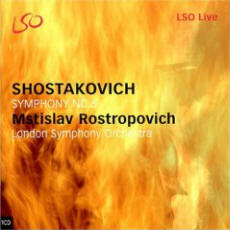|
You are reading the older HTML site
Positive Feedback
ISSUE
27
Shostakovich, Symphony No 5 - Mstislav Rostropovich, London Symphony Orchestra, LSO Live SACD Hybrid 0550
and LSO Live CD 058
The background surrounding Shostakovich and his Fifth Symphony is at least unique if not quite unusual. Without going into great detail, let me just say that he wrote the Symphony while under the real threat of his career being ended if not his life! The very real threat was posed by the very probable official Soviet disfavor he was facing. Fortunately, the official acceptance of his outstanding Fifth Symphony plus great public approval dramatically altered the situation. Shostakovich is quoted as describing his new Symphony as "a Soviet artist's practical reply to just criticism". The unanswered question has to be, did he really mean that? There are still some qualities of his earlier compositions remaining. Included are some melodic passages or rhythms such as marches or dances as well as some shrill scoring. Those sections of shrill scoring will show both music lovers and audiophiles the inherent quality of their audio systems. It is still true, after many years and particularly with solid-state components, that the most common readily apparent "Achilles' heel" of many audio components is the inability to cleanly reproduce high-level shrill orchestral sections without adding harshness and distortions. The fact that it is also very difficult to correctly record those same passages, falsely gives listeners reason to regularly blame the recordings instead of suspecting and checking their components. Ignorance can be bliss. The justly famous (and not just for Russian compositions) Russian conductor, Mstislav Rostropovich, again offers an outstanding and possibly definitive performance of one of the finest symphonies of the 20th century. Though superficially very different, underneath there are definite hints of qualities or passages usually attributed to Beethoven. Some of those qualities include a heroic scale, a deeply emotional slow movement and very apparent expansive melodic rhythms in the other movements. The orchestral contributions are not to be faulted. Again the brass and horns are particularly impressive. This outstanding composition is one of my very top choices for introduction to so-called modern large―scale orchestral music. Three others are Bartok's Concerto for Orchestra and the Third Symphonies by both Roy Harris and Aaron Copland. The overall audio qualities are accurately described as being, at the very least, quite good but perhaps not quite the equal of the LSO Live's best. That may be the same as saying the LSO Live's "latest releases", such as the above mentioned Beethoven Symphony No 3 recorded about a year after this Shostakovich release. In may be a partial explanation of the subtle but definitely noticeable audio quality differences and proof that their audio engineers have been learning and are now close to mastering the combination of a great orchestra performing in a not quite so great recording location. I may have been a bit too quick to reach a conclusion. I had also received the SACD (hybrid) release of this recording. Comparing the regular CD version (not the CD layer of the hybrid disc) with the SACD layer of the hybrid disc, I used my reference 2 channel (stereo) system. The heart of that system may be the rather superb Allen Wright's highly modified Level 5+ Sony SCD777-ES player. Do not confuse that top loading model's number and performance with Sony's confusing use of a similar numbering for a very different performer. I should mention that it had been many years since I would have ever again even considered modifying any audio component. I have to also mention that I am still pleased to have purchased this Sony to have it modified. I need to acknowledge that there is a distinct possibility of a couple of new expensive players that may equal or surpass its overall performance. I simply must give this background information before making a profound and possibly controversial statement. Using this same player with the appropriate CD or SACD selection for the two recordings, the audible differences were readily apparent and easily repeatable. I seem to enjoy a reputation of not using hyperbole in my reviews. My conclusion in this situation, with these two versions of the same recording, is that in almost every way the SACD version is at least subtly if not slightly or noticeably and simply better-not just different! Simply listening overall instead of trying to dissect the listening experience reveals that the overall result for music lovers would be greater, and more realistic and enjoyable than the sum of the parts. Audiophiles might conclude that some of the better parts might be more enjoyable than the whole. If you have any question about the distinct superiority of SACD, buy, rent or borrow both versions and simply listen-you will not need to strain to hear the improvement. If you do not hear significant audible differences then one of two things is probably true. Your hearing acuity, or lack of it, does not bother you by alerting you to audible flaws or inconsistencies with reality or your player does not reveal differences or flaws to you. The latter is easily proven by even briefly substituting a highly recommended (by PFO of course) SACD/CD player. Happy listening and make the companies continue to put out the best audio releases by creating demand for them by purchasing same!
|

